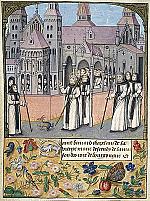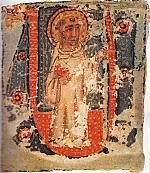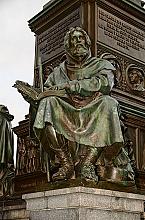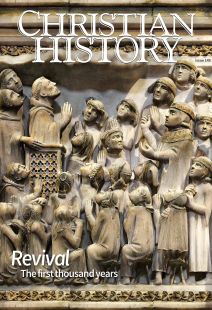Countering insult and shame
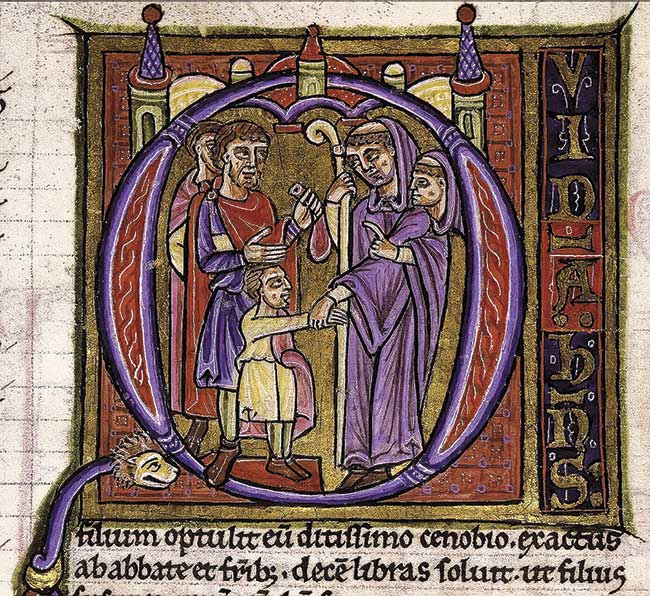
[Illumination depicting simony from Decretum, late 12th Century, Northern France. Douai BM MS 590 f. 3—Public domain, Douai Municipal Library]
Sometime around 1015 in Tuscany, a man named Hildebrand was born. Educated by monks in Rome, he quickly entered church service, especially serving John Gratian (d. 1047, the future Pope Gregory VI) and Bruno of Toul (1002–1054, later Pope Leo IX). By the middle of the eleventh century, the church had been humiliated by a century of scandals and rival claims to the papacy. In Rome a group of reform-minded men formed to call the church back to her pure roots. Hildebrand took a leading role in the group, especially after he was appointed archdeacon (chief financial officer) of the church in 1059. In 1073, upon the death of Pope Alexander II, Hildebrand was elected pope, taking the name Gregory VII.
For a price
As pope, Gregory VII continued to strive for reform, believing that the spiritual would triumph over the material and that the Roman Church would provide leadership as the head of all other churches. This series of changes became known as the “Gregorian reform,” though Gregory did not initiate all elements. He particularly tried to fight two corrupt practices he held responsible for the church’s recent failings: simony and lay investiture.
Simony was a particularly prevalent practice during the High Middle Ages. Named after Simon Magus’s attempt to buy apostolic power from the apostle Peter in Acts 8:18–24, it denotes the practice of purchasing or selling spiritual things (such as ecclesiastical offices) instead of earning or being given such roles. For the right price, a priest who wanted to become a bishop could simply purchase the office either from a secular ruler who had the right of appointment or else from the church itself. Even the papacy trafficked in simony.
Some had already tried—and failed—to wipe out this practice. In 451 the Council of Chalcedon had forbidden ordination in exchange for money, and Pope Gregory the Great had continued to denounce the practice during his papacy from 590 to 604. The Third Lateran Council of 1179, nearly a century after the pontificate of Gregory VII, would continue to speak against it. As late as the Council of Trent in the 1560s, the church’s leadership would still be worried about it.
Gregory’s reform attempted, unsuccessfully, to eradicate simony. It did this by admonishing laypeople to reject the ministry of any clergyman known to have bought his office. Gregory believed that though laypeople could reject the work of a “simoniac,” they had no authority by God to elect or appoint clergy; only other clerics reserved that right. Consequently Gregory attacked not only simony itself but a practice known as lay investiture.
When a man was elected to—or purchased—an episcopal office, he was invested with the symbols of the office: a ring and a crosier. By the twelfth century, a layperson, often the king himself, regularly presided over this investiture. For Gregory this was unacceptable—it gave the king far too much influence over and control of the church, especially when coupled with simony. In 1075 he issued a decree outlawing the practice, infuriating Holy Roman Emperor Henry IV (1050–1106). In response Henry declared in 1076 that Gregory was deposed, going so far as to establish an antipope who called himself Clement III. Gregory responded by excommunicating Henry.
This clash of spiritual and political powers rippled throughout the empire. Excommunication meant Henry’s subjects no longer had to obey him. It created a situation so intolerable for Henry that ultimately he was forced to submit to Gregory in January 1077 after three days of penance in the harsh winter climate at Canossa in northern Italy. Gregory excommunicated Henry again in 1080 for failing to truly reform, leading Henry to install another antipope. Henry eventually seized the city of Rome in 1084, forcing Gregory to die in exile on May 25, 1085. Collectively this series of events has come to be known as the Investiture Controversy.
“I am truth”
At the heart of Gregory’s reform movement was the adage, first formulated by Tertullian (c. 155–c. 220), that Christ did not say, “I am custom,” but rather, “I am truth” (John 14:6). The idea that truth is superior to custom became the guiding principle of Gregory’s reforms, but it bumped up against the common assumption that any innovation is bad. To avoid that charge, Gregory rooted his reforms in appeals to the Scriptures and the church fathers, both of which were seen as indisputable sources for Christian faith and life. If reform recalled the practices and convictions originally set forth by Jesus Christ and his earliest followers, then, Gregory argued, as many renewal preachers have since, his reforms were not innovations. As he wrote to Werner, the archbishop of Magdeburg, “We do not set before you our own decrees . . . but we renew things decreed by the holy fathers.”
Innovate, argued Gregory, was actually what Emperor Henry had done and what the simoniacs did when they appropriated the rights and God-given prerogatives of the church and its rightly appointed leadership. “You have heard, brother,” wrote Gregory to Werner,
the novel and unheard-of presumption, you have heard the atrocious loquacity and boldness of schismatics and blasphemers of the name of the Lord in blessed Peter, you have heard the pride which has reared up to the insult and shame of the apostolic see, such as your fathers have not at any time seen or heard nor does the sequence of things written teach that the like has ever come forth from pagans or heretics.
Gregory also envisioned implementing his reforms by strengthening the role and office of the papacy, a natural corollary to his desire to limit the influence and function of kings and other powerful lay rulers in the church. Emperor Henry’s humiliation at Canossa strengthened the image of a powerful papacy—for there, standing in the snow repentant, was the man with the greatest amount of power in all of Europe. Gregory’s power lay in his ability to excommunicate anyone; excommunication cut the excommunicated off from the sacraments and, ultimately, from salvation.
But excommunicating kings and secular rulers formed only one element of Gregory’s reforming goals. In 1075 he wrote a series of 26 short declarations that he called Dictatus papae (dictation of the pope). All of the declarations establish the primacy of the papacy and the authority and power of the pope, who can “depose or reinstate bishops” and “be judged by no one.”
Further, the pope’s name is to “be recited in churches” and only he “is rightly called ‘universal’” bishop, since he presides over the Roman Church that “has never erred, nor will it ever err.” Though Gregory’s pontificate was not the high point of papal supremacy, it set in motion a series of events that would forever change the nature of the papal office (and, as articles in the rest of this issue will show, provoke a reaction).
Monks take the message out
Ecclesiastical reform, of course, is never accomplished by merely talking about it or theologizing about it. It has to be put into motion. Given the geographical and linguistic breadth of medieval Europe, it was difficult for popes to do this. But one set of men and women could carry a reforming impulse across all the nations and was capable of bridging geographical and linguistic divides—monks and nuns.
During Gregory’s lifetime the most influential group of monks in the Latin church were connected with the French abbey of Cluny. Founded in 910 the monastery at Cluny rapidly grew into a very large community with many monks and financial resources. In due time it began to found daughter houses across Europe, expanding reforming zeal and reestablishing a vivacious Benedictine observance across the landscape.
Placed directly under the oversight and protection of the pope, Cluny and its many dependent monasteries became centers of papal influence. By the time of Gregory’s papacy, hundreds of Cluniac monasteries existed—but as with most reforming movements, the initial reforming zeal had become stunted and practices had solidified that no longer served reform. Though Cluny had been founded to help reinvigorate Benedictine monasticism along the lines laid out in the Rule of Benedict, it soon developed its own institutional ethos at odds with the Rule, thus creating the need for a reform of the reform.
Founded in 1098 by the monk Robert of Molesme to incorporate just such reform, the “New Monastery” at Cîteaux secured a lasting footing under its first abbots, Alberic and Stephen Harding. Dissatisfied with the spiritual state of his own monastery, Molesme (a Cluniac monastery), Robert wanted to establish a more authentic observance of the Rule. So, along with a number of other monks, he moved to a forest in the Burgundian region of France, near Dijon.
Though the pope ordered Robert to return to Molesme in 1099, the new monastery began to grow, especially after 1108 under the guidance of Abbot Stephen. In 1112 a man named Bernard entered the community along with some of his family members. Because of the influx of new monks and because of Bernard’s talents, the community grew rapidly, founding four daughter houses between 1113 and 1115.
The most well-known of these houses, Clairvaux, was placed under the oversight of Bernard, whose influence through his sermons and writings continued to grow (see p. 16), so much so that by the time of Bernard’s death in 1153, more than 340 Cistercian (i.e., of Cîteaux) monasteries flourished. By 1200 this number grew to 500, and, on the eve of the Reformation, over 700 Cistercian monasteries dotted Europe.
A bold vision
Cistercians were generally theologically conservative and loyal to the pope and his bishops over secular rulers. Bernard himself, a particular favorite of several popes, intervened in 1130 when a schism resulted in the election of two rival popes. Bernard supported Pope Innocent II (d. 1143) and took up his pen, writing to others to do the same.
The Cistercians also renewed a careful observance of the Rule of Benedict, paying special attention to its liturgical requirements regarding daily prayer. Bernard, along with Cistercians William of St. Thierry (c. 1080–1148), Aelred of Rievaulx (1110–1167), and others, wrote a large number of spiritual treatises that greatly impacted the spiritual life of the church, giving rise to a renewed Augustinianism that emphasized affect over intellect. Bernard’s influence lasted well into the Reformation; he became a particular favorite of both Martin Luther (1483–1546)—who ranked him the second greatest church father, just behind the fifth-century Augustine of Hippo—and of John Calvin (1509–1564).
The influence of the Cistercians by way of their many monasteries and popular writings gave the papacy a powerful ally during the centuries when it was claiming for itself special prerogatives unknown in earlier centuries. Though the church is always in need of reform and is, in fact, always reforming, the Gregorian and Cistercian reforms changed the medieval landscape and the nature of the church itself.
Though not all of Gregory’s reforms came to fruition, and though many of them did not last, Gregory demonstrated a vision that the pope ought to be, in God’s economy, above and more powerful than any secular ruler. Gregory’s vision proved a bold one. Secular rulers would constantly challenge this idea of playing the proverbial second fiddle, with tensions between popes and kings continuing well into the modern era.
The Cistercian reform showed that one could be deeply spiritual and committed to the pursuit of holiness while also supporting the reforming zeal of the vicar of St. Peter. Cistercian influence continues today, in a church always in need of reform. CH
By Greg Peters
[Christian History originally published this article in Christian History Issue #149 in 2023]
Greg Peters is a professor in the Torrey Honors College of Biola University and the author or editor of a number of books including The Story of Monasticism and Reforming the Monastery.Next articles
Bernard of Clairvaux’s labor of love
Mentor to popes, advisor to royals, arbiter of heresies, and author for the ages
Paul RoremLooking for the last emperor
Some medieval thinkers and writers sought reform because they thought the end was coming
Randolph DanielPoor in spirit, new in Christ
While they looked for renewal, the Waldensians looked like trouble
Alan KreiderPraying and preaching for a better church and society
Revival and renewal took many different forms in the High and late Middle Ages
Jennifer BoardmanSupport us
Christian History Institute (CHI) is a non-profit Pennsylvania corporation founded in 1982. Your donations support the continuation of this ministry
Donate



